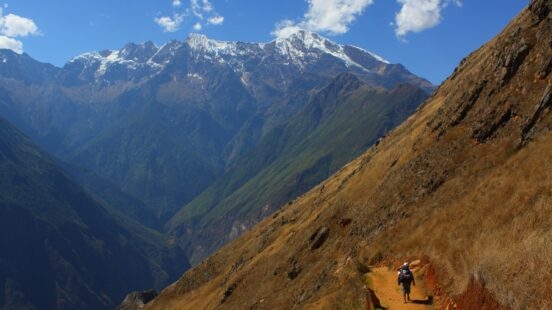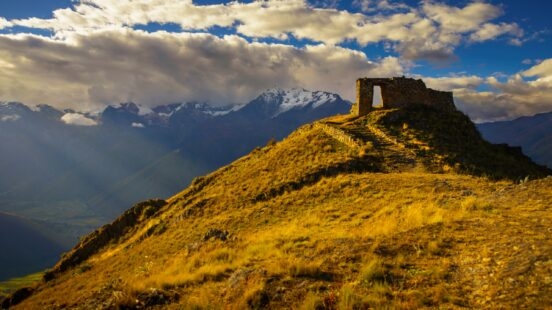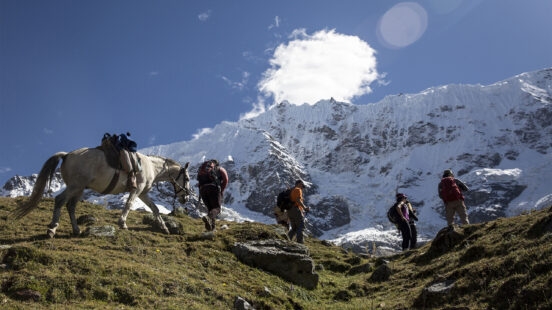Peru has breathtaking scenery and is world famous for being home to the Sacred Valley of the Incas and the ancient citadel Machu Picchu. It’s also an extremely popular destination for hikers, as it offers so many different hiking routes for trekkers of all levels and ages.
With so many alternatives to the classic Inca Trail, it can be hard to know which hiking trail to choose.
To help you with this difficult choice, we’ve put together this guide on the best treks in Peru and picked our favourite Cusco walking trails.
The Ausangate trek
The Ausangate trek is a challenging trail for travellers wanting to get off the beaten path and visit some of the wildest areas that Peru has to offer. Although it’s one of the most arduous treks in the Cusco region, hikers are rewarded with remarkable landscapes and panoramic mountain views. Starting from the village of Tinqui, the trail leads hikers through lush valleys and rural villages up to the spectacular highlands of the Peruvian Andes, surrounding the 6,843 metre peak of Nevado de Ausangate. Here, travellers can watch Andean condors fly overhead and llamas graze on the mountainside. Hikers spend their days walking past hot springs and sparkling lakes to reach an altitude of 5,200 metres.

This is a tough trail but the trek’s signature rainbow mountains in the Vinicunca area make all the hard work worth it. Ausangate mountain itself is considered a holy mountain by Peruvians, and is widely regarded as the deity of Cusco amongst locals. One of our favourite Ausangate trails runs for six nights, with overnight lodge accommodation and luggage transported for hikers by horse. The trail is closed during the rainy season, which runs from November to March, so avoid travelling to Peru during this period if you have your heart set on completing the Ausangate trek.

Choquequirao
Travellers must follow an Inca trail that runs between two ancient citadels to reach the remote ruins of Choquequirao. This week-long, 65 kilometre trek is not for the faint-hearted. Similarly to Ausangate, though, walkers are rewarded with spectacular views. Travellers first descend into the canyon of the Apurimac river before journeying back up to the ancient Inca fortress of Choquequirao, which lies atop a high ridge in the Andean peaks. This ancient Incan site is far less visited than Machu Picchu is due to its remote location, so it’s a great trek for any traveller looking to discover Inca ruins in a challenging yet exclusive way.

From the ruins of Choquequirao, travellers can hike through Cordillera Vilcabamba amongst mountains that rise up to 6,000 metres. Following an ancient pathway that would have been taken by the Incas between Choquequirao and Machu Picchu, hikers can get a glimpse into what life was like for these people of ancient times. On this seven-day tour, six days are spent trekking with five nights of camping, while luggage is transported by horse.

The Huchuy Qosqo trail
The Huchuy Qosqo trail is far less challenging than the Ausgante or Choquequirao trails are, but it still a worthwhile trek. This 15-kilometre trek reaches heights of 4,300 metres above sea level, with the chance to pass through rural villages and trek along a section of the original Inca trail. The ancient site of Huchuy Qosqo is set on a plateau overlooking the Sacred Valley and Vilcabamba mountain range. After hiking down into the Sacred Valley and on to Ollantaytambo, hikers then transfer onto the iconic ruins of Machu Picchu.

As the shortest and easiest alternative trek to Machu Picchu, the Huchuy Qosqo trail is ideal for travellers who are short on time or who would like to experience hiking that isn’t too strenuous. A two-day tour of Huchuy Qosqo and its surroundings incorporates one full day of hiking, while a three-day tour incorporates two days of hiking and one night of camping. If you’re hiking for one day, your luggage will be sent by train. If you’re spending two days walking, your luggage is transported by both train and mule.

The Inca trail
The famous Inca trail is a moderate trek and is the classic route that most travellers take to reach Machu Picchu. This classic four-day trek takes travellers along the same route that the Incas would have taken to reach the ancient citadel, transporting hikers back in time. Starting at an elevation of 2,800 metres and reaching an altitude of 4,200, the trail winds through cloud-forest, past Incan ruins and down into sub-tropical jungle. The views of surrounding mountains and valleys are spectacular, making the journey to Machu Picchu almost as impressive as arriving at the citadel itself.

On the Inca trail, your first glimpse of Machu Picchu is from the iconic sun gate, where you can look down on the ruins before other tourists begin to arrive. The renowned Inca Trail trek involves four days of trekking and three nights of camping, with luggage carried by a porter. Keep in mind that a permit is needed to walk this trail, and it is closed every February for maintenance.

The KM 104 trek
The shorter KM 104 trek allows travellers to experience a section of the Inca Trail without having to complete the whole four day hike. If you’re short on time or just want to experience a less challenging trek, set out on the 12-kilometre KM 104 route that reaches an elevation of just 2,700 metres. Starting from the town of Aguas Calientes, the KM 104 ascends gradually up to the ruins of Wayna Wayna, before continuing on to join the last section of the classic Inca Trail.

This last section of the classic trail winds its way down to Inti Punku Sun Gate, where you can get an incredible view over Machu Picchu before you hike down to reach it. The two-day tour of KM 104 includes one full day of trekking; a permit is needed for the trek and luggage is transported by train.

The Lares trail
Following the Lares trail is the best way to get a glimpse into authentic Andean life. On the four-day trek through the Lares Valley, hikers can meet local indigenous people along the mountainsides. Mountains and valleys here reach an altitude of 4,500 metres, with forest and alpine lakes dotted throughout the picturesque land.

To get an insight into how local Andean people live, hikers can visit rural villages and meet direct descendants of the Incas, while passing farmers tending to their land. On a tour of the Lares Trail, travellers will cover 35 kilometres over five days of moderate trekking with three nights camping or in lodges. Luggage is transported by vehicle or on horseback.

The Salkantay trail
The Salkantay trail takes you through high-altitude snow capped mountains, reaching heights of 4,650 metres, as well as low lying sub-tropical rainforest. This ancient Inca pathway leads travellers through remote landscape in the city of Molletata in Cusco to Machu Picchu. Then, hikers will pass the imposing 6,271 metre glacier-capped Mount Salkantay, meaning ‘savage mountain’ in the local dialect of Quechua.

This hike is on the more challenging end of the scale, but has spectacular views at the end over Machu Picchu. The seven day Salkantay trek involves six days of trekking and six nights in luxury lodges, but more adventurous travellers can also opt to stay in camps. During the trek, luggage is transported by horse.

Discover the best treks in Peru
Feeling inspired? Our expert travel designers are always on hand to help you discover the best walking trails that Cusco has to offer.




